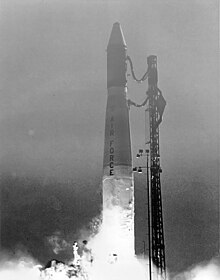 Launch of the last Thor DSV-2U carrying DMSP-5D1 F5 | |
| Function | Expendable launch system |
|---|---|
| Country of origin | United States |
| Size | |
| Mass | 49500 kg |
| Stages | 3 |
| Capacity | |
| Payload to LEO | 500 kg |
| Launch history | |
| Status | Retired |
| Launch sites | Vandenberg SLC-10W |
| Total launches | 5 |
| Success(es) | 4 |
| Failure(s) | 1 |
| First flight | September 11 1976 |
| Last flight | July 15 1980 |
| First stage - Thor DM-19 | |
| Engines | LR79-7 |
| Thrust | 758.71 kN |
| Specific impulse | 282 |
| Burn time | 165 |
| Propellant | LOx/Kerosene |
| Second stage Star 37XE | |
| Engines | TE-M-714-4 |
| Thrust | 45 kN |
| Burn time | 66 |
| Propellant | solid |
| Third stage - Star-37S-ISS | |
| Engines | TE-M-364-15 |
| Thrust | 51.1 kN |
| Burn time | 60 |
| Propellant | solid |
The Thor DSV-2U or Thor LV-2F Star-37XE Star-37S-ISS was an American expendable launch system used to launch five DMSP weather satellites between 1976 and 1980.[1][2] It was a member of the Thor family of rockets, and a derivative of the Thor DSV-2.[1][3]
The first stage was a Thor missile in the DM-19 configuration. A Star-37XE was used as the second stage, and the third stage was a Star-37S-ISS.
Thor boosters used an erector system to hoist them up to the pad. While common on Soviet launch vehicles, this method was unusual in the US space program.
- ^ a b "Thor-LV2F Star-37XE Star-37-S-ISS". Gunter's Space Page. Retrieved 2024-04-12.
- ^ "Thor DSV-2U". www.astronautix.com. Retrieved 2024-10-11.
- ^ Wade, Mark (2013-08-17). "Delta". Archived from the original on 2013-08-17. Retrieved 2024-04-12.
